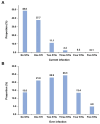Understanding dynamics and overlapping epidemiologies of HIV, HSV-2, chlamydia, gonorrhea, and syphilis in sexual networks of men who have sex with men
- PMID: 38628844
- PMCID: PMC11018893
- DOI: 10.3389/fpubh.2024.1335693
Understanding dynamics and overlapping epidemiologies of HIV, HSV-2, chlamydia, gonorrhea, and syphilis in sexual networks of men who have sex with men
Abstract
Introduction: We aimed to investigate the overlapping epidemiologies of human immunodeficiency virus (HIV), herpes simplex virus type 2 (HSV-2), chlamydia, gonorrhea, and syphilis in sexual networks of men who have sex with men (MSM), and to explore to what extent the epidemiology of one sexually transmitted infection (STI) relates to or differs from that of another STI.
Methods: An individual-based Monte Carlo simulation model was employed to simulate the concurrent transmission of STIs within diverse sexual networks of MSM. The model simulated sexual partnering, birth, death, and STI transmission within each specific sexual network. The model parameters were chosen based on the current knowledge and understanding of the natural history, transmission, and epidemiology of each considered STI. Associations were measured using the Spearman's rank correlation coefficient (SRCC) and maximal information coefficient (MIC).
Results: A total of 500 sexual networks were simulated by varying the mean and variance of the number of partners for both short-term and all partnerships, degree correlation, and clustering coefficient. HSV-2 had the highest current infection prevalence across the simulations, followed by HIV, chlamydia, syphilis, and gonorrhea. Threshold and saturation effects emerged in the relationship between STIs across the simulated networks, and all STIs demonstrated moderate to strong associations. The strongest current infection prevalence association was between HIV and gonorrhea, with an SRCC of 0.84 (95% CI: 0.80-0.87) and an MIC of 0.81 (95% CI: 0.74-0.88). The weakest association was between HSV-2 and syphilis, with an SRCC of 0.54 (95% CI: 0.48-0.59) and an MIC of 0.57 (95% CI, 0.49-0.65). Gonorrhea exhibited the strongest associations with the other STIs while syphilis had the weakest associations. Across the simulated networks, proportions of the population with zero, one, two, three, four, and five concurrent STI infections were 48.6, 37.7, 11.1, 2.4, 0.3, and < 0.1%, respectively. For lifetime exposure to these infections, these proportions were 13.6, 21.0, 22.9, 24.3, 13.4, and 4.8%, respectively.
Conclusion: STI epidemiologies demonstrate substantial overlap and associations, alongside nuanced differences that shape a unique pattern for each STI. Gonorrhea exhibits an "intermediate STI epidemiology," reflected by the highest average correlation coefficient with other STIs.
Keywords: HIV epidemiology; men who have sex with men; modeling; public health; sexually transmitted infections/diseases.
Copyright © 2024 Omori, Chemaitelly and Abu-Raddad.
Conflict of interest statement
The authors declare that the research was conducted in the absence of any commercial or financial relationships that could be construed as a potential conflict of interest.
Figures


Similar articles
-
Sexual network characteristics and partnership types among men who have sex with men diagnosed with syphilis, gonorrhoea and/or chlamydia in Lima, Peru.Sex Transm Infect. 2024 Feb 19;100(2):84-90. doi: 10.1136/sextrans-2023-055910. Sex Transm Infect. 2024. PMID: 38124224 Free PMC article.
-
Diagnosis and Treatment of Sexually Transmitted Infections: A Review.JAMA. 2022 Jan 11;327(2):161-172. doi: 10.1001/jama.2021.23487. JAMA. 2022. PMID: 35015033 Review.
-
SOCIO-ECONOMIC FEATURES OF SEXUALLY TRANSMITTED INFECTIONS AMONG MSM IN GEORGIA.Georgian Med News. 2023 May;(338):78-86. Georgian Med News. 2023. PMID: 37419476
-
Quantifying heterogeneity in sexual behaviour and distribution of STIs before and after pre-exposure prophylaxis among men who have sex with men.Sex Transm Infect. 2022 Sep;98(6):395-400. doi: 10.1136/sextrans-2021-055227. Epub 2021 Oct 29. Sex Transm Infect. 2022. PMID: 34716228
-
Syphilis incidence in men who have sex with men with human immunodeficiency virus comorbidity and the importance of integrating sexually transmitted infection prevention into HIV care.Expert Rev Anti Infect Ther. 2018 Apr;16(4):321-331. doi: 10.1080/14787210.2018.1446828. Epub 2018 Mar 5. Expert Rev Anti Infect Ther. 2018. PMID: 29489420 Free PMC article. Review.
Cited by
-
Vaccination as a strategy for Chlamydia trachomatis control: a global mathematical modeling analysis.BMC Glob Public Health. 2025 Jul 25;3(1):65. doi: 10.1186/s44263-025-00181-7. BMC Glob Public Health. 2025. PMID: 40708051 Free PMC article.
-
Can the prevalence of one STI serve as a predictor for another? A mathematical modeling analysis.Infect Dis Model. 2024 Dec 12;10(2):423-428. doi: 10.1016/j.idm.2024.12.008. eCollection 2025 Jun. Infect Dis Model. 2024. PMID: 39816754 Free PMC article.
-
Epidemiology of gonorrhea in countries of the Middle East and North Africa: systematic review, meta analyses, and meta regressions.BMC Glob Public Health. 2024 Aug 19;2(1):56. doi: 10.1186/s44263-024-00088-9. BMC Glob Public Health. 2024. PMID: 39681952 Free PMC article.
References
-
- Silva S, Ayoub HH, Johnston C, Atun R, Abu-Raddad LJ. Estimated economic burden of genital herpes and HIV attributable to herpes simplex virus type 2 infections in 90 low- and middle-income countries: a modeling study. PLoS Med. (2022) 19:e1003938. doi: 10.1371/journal.pmed.1003938, PMID: - DOI - PMC - PubMed
-
- World Health Organization . (2016). Global health sector strategy on sexually transmitted infections 2016–2021. Available at:https://www.who.int/publications/i/item/WHO-RHR-16.09
-
- World Health Organization . (2022). Global health sector strategies on, respectively, HIV, viral hepatitis and sexually transmitted infections for the period 2022–2030. Available at:https://www.who.int/publications/i/item/9789240053779
Publication types
MeSH terms
LinkOut - more resources
Full Text Sources
Medical

